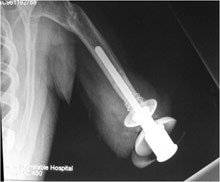Implanting Artificial Limbs in the Body
November 11, 2010 | Source: Technology Review

X-ray of a woman who lost part of her arm. She uses an artificial limb that snaps onto a connector attached directly to the remaining bone. (Gordon Blunn, University College London)
The prostheses currently available to amputees fit over the wearer’s stump. While they can vastly improve quality of life, allowing many people to walk, for example, they also have serious disadvantages. Walking can be quite painful, and friction between the stump and the socket of the prosthesis can lead to chronic sores and infection.
With so-called osseointegrated implants, which attach directly to bone, a cylindrical device is surgically inserted into the hollow of the remaining bone. The goal is to encourage the bone to grow into the metal, similar to what happens after joint replacement surgeries. But the procedure is still quite risky.
Gordon Blunn, head of the Centre for Bio-Medical Engineering at University College London is getting inspiration from deer, whose antlers provide a natural model for a healthy interface between skin and bone. Blunn’s team has focused its efforts on encouraging the skin to form a tight seal around the implant, thereby decreasing the risk of infection. Deer seem to do this via large pores in the bone just beneath the skin. These pores encourage soft tissue to adhere. Blunn and colleagues mimicked this process by adding a porous flange, implanted just below the skin, encouraging the optimal skin seal to form.